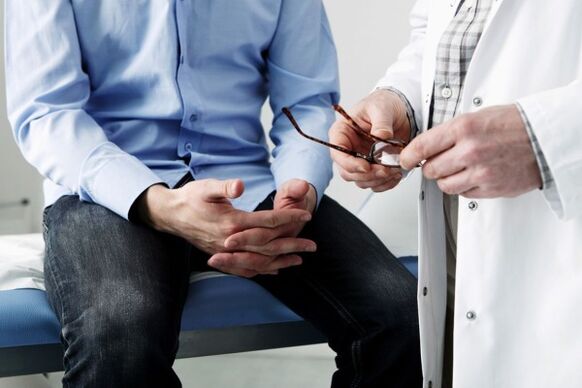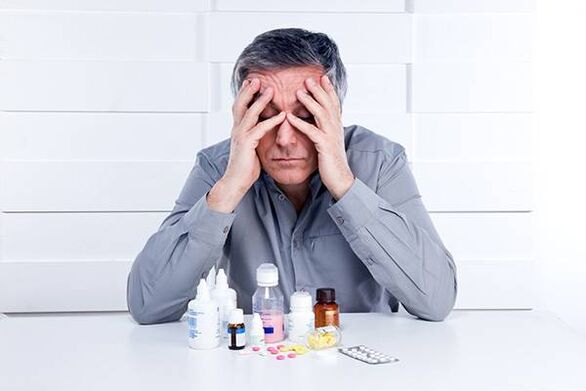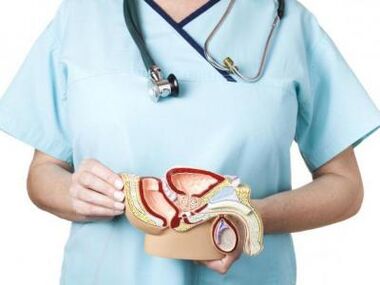Prostatitis is one of the most common urological diseases in men. And this is impressive also against the background of the fact that the current number of patients suffering from this disease is much higher than the recorded statistics. This is explained by the fact that prostatitis can occur in a latent state, and features of the diagnosis.
What does the prostate look like?
%20in%20a%20man.jpg)
It is a small glandular-muscular organ. Located in the pelvic region below the bladder, it captures the initial part of the urethra.
The function of the gland is to produce a secretion that preserves the stability of the sperm in various unfavorable conditions, mixing with the sperm.
What is the prostate in men? Prostatitis is characterized by a variety of disorders related to the urinary system, erectile function, decreased sexual desire and other problems.
Lack of timely and correct treatment is fraught with sad consequences: every fourth patient may have one or another form of infertility, as the prostate gland loses the ability to produce the necessary amount of reliable secretion to ensure mobilityof sperm.
Distinctive symptoms of prostatitis in men can be present not only with this disease, but also with prostate adenoma, a malignant tumor!
signs
What could be the first "bell" of the disease? Variability of manifestations complicates the diagnosis, therefore it is not always possible to immediately determine the presence of the disease. Bacterial prostatitis in its initial symptoms differs from the type of viral origin, such differences are characteristic of the acute and chronic course of the disease.
At the same time, there are main symptoms that should attract the patient's attention:
- Problems with urination. It becomes difficult and painful. This may indicate the initial symptoms of a worsening. The reason lies in the blockage of the urethra by an inflamed and enlarged prostate. Failure to take timely measures leads to a deterioration of well-being due to complete closure of the ureter.
- Sexual disorders. They are characterized by weakening of orgasm and erection.
The listed disorders associated with this disease are far from the only ones and may be just one of the first signals of deterioration.
Along with them, the following signs appear:
- discharge from the urethra;
- floating fibers in urine;
- specific sensations during bowel movements;
- unpleasant burning sensation in the perineum.
Diversity is a characteristic feature of this disease. Therefore, it is necessary to distinguish between the first symptoms of prostatitis in men of the chronic bacterial form from the acute one.
Causes of prostatitis in men lie in a sedentary lifestyle, colds of the genitourinary system.
Characteristics of different forms of prostatitis
The disease can appear in four of the most common forms.
Acute bacterial. It is usually diagnosed in patients under the age of thirty. The disease is characterized by fever - the temperature with the prostate is up to 38 C and above.

As a result of prostate edema, the following is observed:
- acute retention as well as frequency and pain of urination;
- prolonged discharge;
- discomfort in the groin area;
- erectile dysfunction.
Symptoms of sudden onset of prostatitis sometimes include general illness, apathy.
Chronic bacteria. This form is typical for elderly patients. The disease proceeds more quietly, however, a worsening may occur if there are factors contributing to this. Sometimes the disease is asymptomatic.
Not bacterial. Although it is not possible to detect the presence of bacteria, this circumstance does not rule out their presence.
Prostatodinia. It is characterized by compression of prostate tissue without inflammatory symptoms in it.
How to determine
Before an effective treatment can be prescribed, the disease must be identified.

In diagnostics, an important place is given to an integrated approach:
- Collection of anamnesis. To get a reliable picture of the course of the disease, the doctor discovers: the nature of the pain, the presence of discharge, problems of a sexual nature. An analysis of the rectal finger is performed, with the help of which the degree of swelling and pain of the prostate gland is revealed.
- Laboratory research. Often, without them, it is impossible to identify the disease. This is especially true for chronic bacterial prostatitis. To discover the reason, urine culture is described, this helps in determining the pathogen that contributes to the deterioration. Three urine samples are compared for reliability. Sometimes a biopsy and discharge analysis may be required. Venous blood is also analyzed for ESR content and leukocyte count.
- Ultrasonography. Tomography (computer and magnetic resonance imaging). These studies are performed on both the prostate and the adjacent organs.
How it is treated
Important! Medications are prescribed by a urologist. You can not engage in "self-determination" - it will only worsen the course of the disease!
The modern method of treating the disease in men is diverse. You can completely cure the prostate if you go to the doctor on time.
The choice of form and methods is in accordance with the degree of complexity, the time of the disease, the well-being of the patient and the characteristics of his body.
On this depends the appointment of procedures, which can be performed on an outpatient basis or in hospital.
Treatment regimens for acute and chronic prostatitis in the exacerbation phase are practically similar. With timely and adequate treatment, the acute form is completely cured, the chronic one achieves a long-term remission.
Important! The disease gains only an integrated approach to treatment - do not ignore any doctor advice!
Drug therapy
Drug treatment consists of taking antibiotics, non-steroidal pain relievers, alpha-blockers. The former, as a rule, are used to cure the bacterial form.

In the chronic course of the disease, alpha-blockers are prescribed to reduce prostate edema and relieve pain.
Important! It is recommended to use the pills throughout the course, which, as a rule, is at least six months, and not to stop earlier, even when you feel better.
Non-steroidal drugs - for the treatment of acute forms.
Massage

It is considered an effective treatment. Improves blood supply to glandular tissues, when used in conjunction with other methods of treatment, greatly increases the effectiveness of antibacterial and topical therapy.
Thanks to digital stimulation, it stimulates the extraction of secretions from the prostate, which facilitates further self-excretion through the urethra.
Despite the fact that patients often experience discomfort from the procedure, it is not recommended to ignore massage.
Careful! The use of massage procedures is prohibited in case of an acute form of the disease - it is fraught with the spread of infection!
Reflexology
With the help of acupuncture and other methods, the work of the central nervous system is improved, blood circulation and metabolic processes in the body are normalized. Reflexology helps relieve neuralgic pain, prevents the development of inflammatory processes. It is recommended that this procedure be performed in combination with other treatment methods.
Hirudotherapy
This method also finds application in the treatment of prostatitis. The use of caterpillars helps increase blood and lymph flow to the prostate and normalize its functioning.
Rectal suppositories
They directly affect the focus of the lesion, so they are a very effective remedy. Contained in them antispasmodics, anabolic steroids, antibacterial substances are good for preventing irritations.
The effect of ichthyol and buckthorn suppositories is high.
Immune correction
Any patient with this disease is advised to strengthen the immune system. This helps increase the body's resistance, helps slow down the development of chronic prostatitis exacerbations. The complex should use:
- natural methods - active physical exercises, walking in the fresh air, strengthening;
- natural immunomodulators - ginseng, echinacea and others;
- multivitamin complex.
Surgical intervention
At one time, they often resorted to a surgical treatment method. However, in some cases it did not bring high efficiency. In recent years, surgical manipulations have been used primarily for prostate abscesses or narrowing of the urethra.
Thirty years old is already a reason to think about your health. Among patients who have passed this age limit, every third suffers from prostatitis, and after 50 years - every second. And this trend continues to this day.
Now that you know the first signs of prostatitis in men and its treatment, to avoid the disease and further transition to a chronic form, you should be examined regularly by a doctor for timely detection. What to do with prostatitis and where to go every patient should know.






























